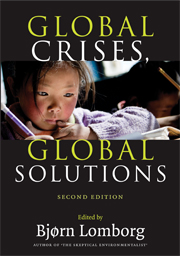Book contents
- Frontmatter
- Contents
- List of figures
- List of tables
- List of contributors
- Acknowledgements
- List of abbreviations and acronyms
- Introduction
- PART I THE CHALLENGES
- 1 Air pollution
- 2 The security challenge in conflict-prone countries
- 3 Disease control
- 4 The benefits and costs of alternative strategies to improve educational outcomes
- 5 Climate change
- 6 Hunger and malnutrition
- 7 Water and sanitation
- 8 The challenge of reducing international trade and migration barriers
- 9 Transnational terrorism
- 10 Women and development
- PART II RANKING THE OPPORTUNITIES
- Conclusion
6 - Hunger and malnutrition
Published online by Cambridge University Press: 05 June 2012
- Frontmatter
- Contents
- List of figures
- List of tables
- List of contributors
- Acknowledgements
- List of abbreviations and acronyms
- Introduction
- PART I THE CHALLENGES
- 1 Air pollution
- 2 The security challenge in conflict-prone countries
- 3 Disease control
- 4 The benefits and costs of alternative strategies to improve educational outcomes
- 5 Climate change
- 6 Hunger and malnutrition
- 7 Water and sanitation
- 8 The challenge of reducing international trade and migration barriers
- 9 Transnational terrorism
- 10 Women and development
- PART II RANKING THE OPPORTUNITIES
- Conclusion
Summary
Despite significant reductions in income poverty in recent years, under-nutrition remains widespread. Estimates published in the Lancet (Black et al. 2008) suggest that “maternal and child Under-nutrition is the underlying cause of 3.5 million deaths, 35 percent of the disease burden in children younger than 5 years, and 11 percent of total global DALYs.” Under-nutrition can be indicated both by anthropometric indices (underweight, stunting, and wasting) and by missing micronutrients in poor-quality diets.
Under-nutrition in turn has negative effects on income and on economic growth. Undernutrition leads to increased mortality and morbidity, which lead to loss of economic output and increased spending on health. Poor nutrition means that individuals are less productive (due to both physical and mental impairment), and that children benefit less from education. The 2004 Copenhagen Consensus paper on the topic discusses these mechanisms in detail (Behrman, Alderman, and Hoddinott 2004) (hereafter, BAH 2004). Reducing under-nutrition is one of the MDGs (Goal 1 aims to eradicate extreme poverty and hunger), and is also a key factor underpinning several others. Achieving goals in primary education, reducing child mortality, improving maternal health, and combating HIV/AIDS, malaria, and other diseases all depend crucially on nutrition.
There are cost-effective interventions for improving nutrition. The first section below discusses the challenge in more detail, the second describes selected priority solutions; the third section undertakes more detailed economic analysis of these solutions, and the fourth and final section discusses the implications of the analysis.
- Type
- Chapter
- Information
- Global Crises, Global SolutionsCosts and Benefits, pp. 305 - 354Publisher: Cambridge University PressPrint publication year: 2009
- 34
- Cited by

